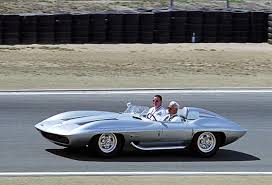By Robert Tate, Automotive Historian and Researcher
Images Courtesy of the General Motors Archives
Published 9.25.2019
 1959 Sting Ray (GM Archives)
1959 Sting Ray (GM Archives)
One of the most popular sports cars was the Sting Ray, developed by General Motors in 1959 under the great leadership of Bill Mitchell of their design staff.
“I always liked the looks of the Sting Ray. It’s my favorite Corvette,” Mitchell said. “That strong shadow underneath makes it very photogenic. The early Corvettes were too rounded, too soft. The Sting Ray has that sharp body edge, and that makes it work.”
 Bill Mitchell with 1959 Sting Ray (GM Archives)
Bill Mitchell with 1959 Sting Ray (GM Archives)
As an automotive memorabilia collector and historian, the 1959 Sting Ray model is one of my favorite automotive designs. When Harley Earl retired on December 1, 1958, the 46 year-old Mitchell was named his successor as the head of General Motors’ styling staff. This would mark the beginning of a new chapter in GM history for developing and engineering great looking automobiles that would dominate the US market for many years to come. Mitchell enjoyed driving powerful cars, and he could handle them very well.
 Sting Ray (GM Archives)
Sting Ray (GM Archives)
The Sting Ray started out with an experimental chassis called the Sebring SS Mule, which was a part of many pre-race laps driven at Sebring in 1957 by the renowned Stirling Moss. Along with Mitchell, Larry Shinoda was also involved with the development of the Sting Ray model, which took place in Mitchell’s “Studio X” special projects area within the GM Tech Center. A fiberglass body was hand-laid for the model in the GM fabrication shop.
 Sting Ray race car side view (GM Archives)
Sting Ray race car side view (GM Archives)
It later became known that the Sting Ray’s racing activities had to be financed out of Mitchell’s own pocket, however, he thoroughly enjoyed the project despite the cost. The agreement was that Mitchell had to keep the Sting Ray model off the GM Tech Center property. Mitchell entered several races, including the President’s Cup Race at Maryland’s Marlboro Raceway on April 18, 1959. Dr. Dick Thompson, one of the SCCA’s top Corvette competitors, was nominated to drive, and Corvette engineer Zora Arkus-Duntov was also in attendance. The Sting Ray did 0 to 60 in four seconds and had a great engine with fuel-injection, which many car fans admired.
 1959 Sting Ray racer (GM Archives)
1959 Sting Ray racer (GM Archives)
The Sting Ray participated in many races and was a very popular model at the racetracks. The 1959 Sting Ray won the 1960 National Class Championship, which was its final race. After the car’s retirement from racing, the Sting Ray became an attraction at events starting with the Chicago Auto Show in 1961.
 Sting Ray on the track (GM Archives)
Sting Ray on the track (GM Archives)
In 1960, the Sing Ray was painted red and later was available in the popular silver color. The exhaust pipes that protruded out and ran along the outside of the lower body gave the car a great design look. The Sting Ray also offered a 92-inch wheelbase and was 1,000 lbs. lighter than a production Corvette from 1960.
 1959 Sting Ray race car rear view (GM Archives)
1959 Sting Ray race car rear view (GM Archives)
Interestingly, the Sting Ray Special racer would carry neither the Corvette nor Chevrolet designations because of the manufacturer’s racing prohibition. However, it later would be called a Corvette on its subsequent tour of car shows. The 1959 Sting Ray show car would continue to receive great recognition from many fans around the world, and Mitchell would later use the Sting Ray as a design template for other GM products. After the car was retired, Mitchell started using the model on the road. Later, the Sting Ray was given a new windscreen design and a much longer grille for the two-hood vent design, creating a sportier look.
In conclusion, the Sting Ray was a well-liked model in 1959. Today, it still has a huge following. For images of the Sting Ray or other related Corvette models, contact the GM Photo Store at www.gmphotostore.com.
Bibliography
Ludvigsen, Karl. “Corvette: America’s Star-Spangled car The Complete History.” Automobile Quarterly, 1973-1974.
Auto Editors of Consumer Guide. “Corvette 50th Anniversary.” 2003.
Auto Editors of Consumer Guide. “Corvette: America’s Only True Sports Car.” 1979.



